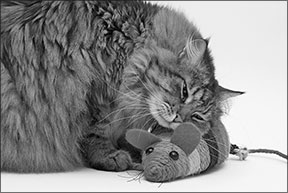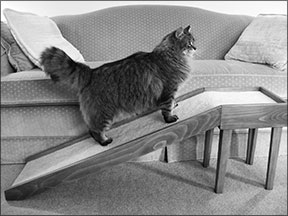Arthritis creeps up on a cat with signs so subtle that they’re easy to miss: getting up more slowly from a nap, dashing after a toy mouse less often, perhaps even losing interest in leaping from the floor to the kitchen counter top.

288
It hurts to realize that your cat hurts, but you play an important part in his comfort when the diagnosis is arthritis. The condition can’t be cured, but veterinary care and a few easy changes around the house can keep both of you happier.
The first step is a trip to the veterinarian to learn the cause of the pain. A physical exam, blood tests, X-rays and other tests can help determine whether the pain results from an infection, autoimmune disorder, injury or simply the toll of age.
Worn Cartilage. All types of arthritis involve degeneration of the cartilage covering the ends of bones in joints. Normally smooth, the cartilage allows joints to move easily. As the cartilage breaks down, the joints don’t move as well and bones rub together, resulting in inflammation, stiffness, swelling and soreness. The condition has no cure but can be treated to keep a cat more comfortable.
Orthopedic surgery is seldom an option for arthritic cats, says Rory J. Todhunter, BVSc, Ph.D., Professor of Surgery at the Cornell University College of Veterinary Medicine. Because cats are so small, the surgery is difficult and impractical.
When cats do develop arthritis, they’re good at hiding signs of pain, such as limping, that tell their owners that they’re hurting. Consequently, their owners are much less likely to take their cats to a veterinarian for treatment. “We might see only one cat to 20 to 50 dogs with orthopedic disease,” Dr. Todhunter says.
Most arthritis cases at Cornell are managed medically, he says. Even surgery, however, calls for an owner’s help to make it work. “Arthritis is a global disease, and fiddling around in the joint isn’t going to solve it. Once you’ve got the damage, it’s there forever.”
This is where you come in. Here are changes you can make at home to improve an arthritic cat’s life. The good news: Most of them don’t cost a dime.

288
Trim the weight. Getting an overweight or obese cat to the proper weight may reduce or eliminate the need for medications, Dr. Todhunter says. “You need to do it slowly and be persistent. Remember the rule is ‘Calories in and calories out.’ You have to control caloric intake for the pet to lose weight.” It may be as easy as following your veterinarian’s advice about daily calorie intake for your cat’s age and activity.
Provide exercise. “In the best of all worlds, we would not give a painkiller; we would build up exercise to prevent pain,” Dr. Todhunter says, suggesting gentle daily exercise that’s kind to aching joints. This means batting a toy mouse around the floor is adequate, but jumping to catch a toy mouse dangling from a string is excessive. High-impact play, such as leaping, is off the list. Outside play on leash and harness, laser play, climbing on natural substances and even remote-controlled feeding and grazing devices help with weight loss.
Redo the restroom. If you have a multi-story house, keep the litter box on the floor in the room where your cat spends the most time. That way, he won’t be forced to climb stairs. Speaking of climbing, a pan with a lower entry or lower sides can make elimination easier.
Keep it comfortable. Lucky cat, if you have low windows facing the sun. Make the most of the warmth by giving him a place to nap there. Place his bed in a warm location on the floor for extended naps. Although your cat may love curling up to sleep on soft blankets and pillows, what’s underneath them is better firm because it makes rising easier.
Up and down. Some cats with arthritis take well to using ramps instead of steps to access short flights of stairs. Others turn up their whiskers at it. If your cat is a potential ramp user, you can buy a ramp or build a low-angle one from plywood covered with carpet, making sure that both ends of the ramp will stay put when your cat is on it.
Raise the bowl. Elevated food and water bowls are increasingly common in pet stores, but you can accomplish the same effect by placing your cat’s bowls on a low box or upside-down bowl — if he needs it. Don’t think you have to raise the food bowl unless the cat has neck pain, Dr. Todhunter says.
Small changes around the home play a large role in maintaining an arthritic pet’s quality of life, Dr. Todhunter says. “What owners can do can make a big difference.” ❖



